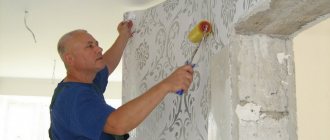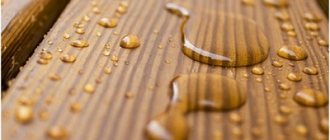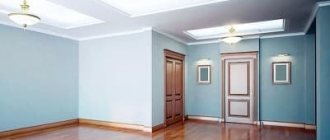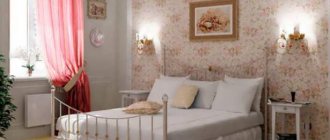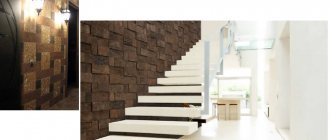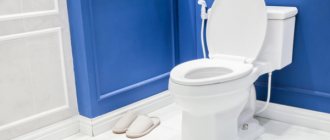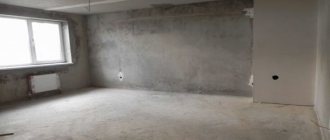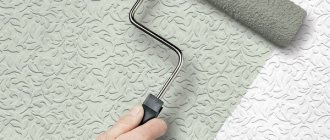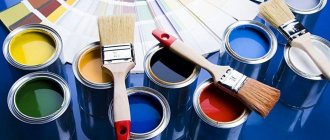Wallpaper is cheaper
Traditional colored canvases have a huge range of prices: you can purchase both affordable paper ones and more expensive premium ones.
At the same time, wallpaper can be combined using budget canvases on the main walls, and luxury ones only on accent walls. The cost of plaster is higher than that of a competing material, and even the cheapest mixture will be more expensive than an alternative finish.
Plaster looks more noble
Decor created using plaster made on a mineral, acrylic or silicone base always looks more impressive due to its texture and method of application. The finishing is handmade and therefore unique. The composition can imitate fabric, stone, concrete, wood and leather, looking luxurious or natural.
Venetian plaster with a silky shine and stone pattern is particularly chic, giving the interior a certain pomp. Actively used when recreating a classic style.
Wallpapers have a wider choice
But if the decor needs rich colors and prints, you should turn to wallpaper. No other material can compare with them in terms of diversity: canvases come in paper, vinyl, bamboo, non-woven and textile.
In addition, there are glass wallpapers, photo wallpapers and metallized canvases. They all have their own characteristics that help realize the most daring design ideas.
When visiting a hardware store or salon, you immediately see the finished design and shade before your eyes, and you can easily imagine it in your interior.
Plaster is more durable
It contains polymer additives that give it special strength. The finished surface is additionally protected with varnish or wax. The service life of decorative plaster ranges from 20 to 60 years. Ordinary wallpaper lasts on average about 5 years, non-woven wallpaper - 10, fiberglass - 20.
When choosing plaster as a finish, keep in mind that you won’t have to change the appearance of the room anytime soon, and re-decorating the walls will be more hassle than re-pasting the wallpaper. The good news is that the plastered surface can be painted.
Comparison of parameters
When purchasing finishes, pay attention to cost, durability and ease of use of raw materials. One type is perfect for the bedroom and nursery, the other - in the living room, kitchen or bathroom. A comparative review of the characteristics will help determine which wallpaper or decorative plaster is better in a house or apartment.
Vapor permeability
For a favorable microclimate in the room, the finishing must allow air to pass through. If the vapor permeability of the material is low, the room will be humid. Moisture on the walls accumulates under coverings made of vinyl, aluminum foil or cheap detergents.
Non-woven, liquid and paper trellises “breathe” well, so fungus does not appear on the walls under the canvases. Among decorative plasters, cement-sand and gypsum types have such characteristics.
Vapor permeability of the material Source centrpol.com.ua
Durability
The service life of wallpaper varies between 5-12 years. The final relief coating can last 40 years, the Venetian model - more than 50. The duration of use is influenced by the quality of the raw materials and strict adherence to application technology.
Resistance to external influences
Decorative plaster perfectly withstands impacts, scratches and abrasions. The material does not fade under directed ultraviolet radiation and does not mold at high humidity. If you use moisture-resistant types of wallpaper, then the wall must first be treated with antibacterial impregnation. Liquid models are coated with a special protective varnish on top, but they will not survive a directed flow of water.
Decorative plaster in the interior Source mywoman.info
Trellis based on aluminum foil are considered very capricious. Metal types have average resistance to moisture. If you move the furniture awkwardly or carelessly, the shiny surface can easily be scratched.
Easy to install and dismantle
Before starting work, the partitions must be leveled. If they take the final decorative coating, then the condition of the walls is not important. Tapestries made in the form of canvases are glued onto a perfectly flat surface. Recesses and cracks are clearly visible on thin models, while voluminous ones made of non-woven fabric, vinyl and cellulose fibers hide imperfections.
Which is easier to install Source superstroyka.com
Wallpaper is easier to glue
Most of the work on decorating walls with wallpaper is done with your own hands. Particularly dense ones can be applied even to a concrete surface without worrying about small irregularities - the canvases will hide these imperfections.
Preparing walls for plastering requires special technologies: the cost of the composition is high, so it cannot smooth out defects. Most of the work is carried out by professionals and includes several stages, but if you wish, you can master the technique yourself.
Roll wallpaper or decorative plaster?
Wallpaper is the most popular material for wall decoration in the budget segment of interior decoration. However, they can also be quite expensive. The cost is significantly influenced by manufacturing technology, the attractiveness and complexity of the picture, and the country of origin.
Pros of wallpaper
- Wallpapering is considered a simpler operation than working with decorative plaster. This is reflected in the prices of construction companies; the labor of finishers in this case will cost less.
- Because of the simplicity of this finishing, anyone can do it. Wallpaper can be hung quite well on your own without the involvement of specialists; obtaining high-quality decorative plaster by an inexperienced person can be a difficult task.
- This is a rolled material, knowing its width and length, as well as the area of the walls, it is easy to calculate how many pieces you need to purchase.
- High-quality wallpaper from well-known brands is stored for a very long time without loss of useful performance characteristics. Unused material can always be used to repair the coating or decorate another room.
- The appearance of the walls can be changed every 2-3 years without a heavy burden on the family budget.
Flaws
- Standard paper wallpaper is very flimsy and often breaks when applied in the hands of non-professionals.
- Textiles absorb dust and therefore need to be vacuumed periodically.
- Washable ones do not stick well to walls; they need a completely dry surface.
- They are not suitable for finishing rooms with high humidity.
- If the gluing technology is violated, there is a risk of fungus appearing under the wallpaper.
Expert opinion
Marina Zanina
Interior designer
Textured plaster has always been a fairly popular finishing option. There are solutions of different properties and appearance; if desired, you can plaster any wall. The coating will fit normally in the bathroom, on the facade, in the living room, etc. Regarding appearance, decorative plasters have no fewer ready-made colors, but with their help you cannot get a colorful pattern like, for example, photo wallpaper.
Benefits of plaster
- Decorative plaster imitates different materials: marble, masonry, wood, fabric, leather, etc.
- In the process of applying it, a unique pattern is created. Self-tinting allows you to get any desired shade.
- There are no seams on the wall.
- The material is durable, heat and moisture resistant, and resistant to ultraviolet radiation. It can be used outdoors, in the bathroom, swimming pool, kitchen.
- This type of coating plays the role of additional heat and sound insulation.
- Plastering of the ceiling is possible.
- Serves approximately 10-15 years.
- Washing does not harm the coating.
Flaws
- To get high-quality decorative plaster, you will have to hire a professional or spend time mastering the application technique.
- Apply only to a flat, prepared surface.
- Removing dirt from pores is problematic.
The listed pros and cons do not apply to all types of decorative plaster, but are given as general characteristics.
What do you like best?
PlasterWallpaper
It is impossible to clearly determine which finishing is cheaper; it all depends on the specific material; in the finishing segment, the cost for a product with similar properties sometimes differs several times, depending on the manufacturer and the beauty of the decor. Only one thing can be definitely stated: for the work itself, the finishers will take more money when plastering.
Wallpaper has seams
The main disadvantage of wallpaper is the presence of joints that spoil the appearance of the room. This especially affects budget paper products that are glued with an overlap.
To level out the seams, you should purchase thick wallpaper, which fits better on smooth walls, and carefully adjust the pattern. A good solution is canvases a meter or more wide, as well as expensive seamless products.
The plaster has a pronounced relief
Using this material it is easy to create a bright, memorable texture. The most popular and affordable is the “Bark Beetle”, which contains a mineral filler and granules of different sizes. “Sandstorm” and “Travertine”, which imitate stone, are applied in various ways and allow you to create a unique relief reminiscent of the surface of rocks.
For those who do not want to perfectly align the walls, the “Faktura” and “Fur Fur” materials are suitable, and to create a sophisticated interior, a mother-of-pearl composition that imitates silk is used.
The texture of the wallpaper is less pronounced because it is limited by the properties of the material.
Dry plaster
The next type is gypsum sheets with cardboard covering. A popular material when working with ceilings. Has a number of advantages:
- no odor;
- sound and heat insulation;
- hiding wall defects;
- additional opportunity for laying communications (between the cardboard surface and dry gypsum sheets).
However, there remains a significant disadvantage in that you still need to glue wallpaper on top of the cardboard.
Wallpaper is less wear-resistant
Despite the fact that wallpaper is used in the kitchen, on the loggia, and in the bathroom (excluding wet areas), their durability leaves much to be desired. To increase their service life, it is necessary to select vinyl sheets and glass wallpaper for wall decoration. Sometimes finished walls are coated with a protective varnish.
Decorative plaster is used even when finishing facades, where it is exposed to temperature changes and precipitation. The material prevents mold and rotting, and is also highly vapor permeable.
Wallpaper
There are different types of wallpaper, and most of them are suitable for the kitchen. The most common are vinyl and non-woven, which can be sold in a finished form or in white for painting.
Vinyl
This is one of the most common types of wallpaper. The top layer is polyvinyl chloride, the bottom is a paper or non-woven base.
Advantages:
- duration of use;
- strength;
- a large assortment;
- resistance to moisture.
Minuses:
- poor breathability;
- high cost compared to other types;
- presence of vinyl smell for some time after pasting.
Non-woven
This is non-woven or paper-based wallpaper. They contain synthetic and cellulose fibers. Wallpaper is also used for painting.
Advantages:
- acceptable price;
- fire resistance;
- no shrinkage;
- possibility of wet cleaning;
- possibility of re-painting;
- masking cracks and irregularities on walls.
Minuses:
- small selection of colors;
- poor sound insulation;
- prohibition on pasting walls in rooms with poor ventilation.
Plaster can be restored
If the technology was violated during its application (the walls were poorly aligned or not completely cleaned), deep cracks appear on the surface. Small chips and peeling occur if the plaster was not sufficiently wetted during installation.
But it is not difficult to restore a cracked area by knocking down the material in the damaged area to the bare wall, moistening it with warm water and plastering it with the same composition.
As you can see, wallpaper is inferior in wear resistance, but wins in price and variety of assortment. Plaster looks modern and original, but costs several times more and requires special skills when facing.
Criteria for choosing a wall finishing method
With the crisis, durability became the most important quality. And wallpaper here is outright inferior to plaster. Unless, of course, we are talking about liquid wallpaper, which can be updated very quickly and easily. The plaster is strong and can withstand significant physical impact. Wallpaper almost always deteriorates. We can accidentally touch them when carrying furniture and other loads, but our beloved cats very often touch the wallpaper with their claws. So, the prospect of re-finishing it in a short time, or sitting with shabby walls, does not appeal to us.
The second criterion is price, and wallpaper wins here. After all, even the cheapest decorative plaster for walls costs two hundred rubles and more. At the same time, wallpaper can be found for 50 rubles. Of course, there are expensive fabric and metal wallpapers, as well as expensive Venetian plaster. However, in general, wallpaper is still more affordable. If you do not take into account everything that is written in the paragraph above, and exclude the possibility of repeated spending on replacing damaged wall coverings.
Ease of use is also an important factor for those who are planning to do the repairs themselves. It is much easier to hang wallpaper before painting. Options with patterns are already more complicated. Well, the most difficult ones are photo wallpapers, where you need to combine everything very precisely. But even in this case, the process is still simpler than plastering. And therefore, those who have previously had experience working with wallpaper, but have not held a spatula in their hands, are unlikely to decide to plaster the walls.
By the way! In quite a number of cases you will have to work with putty even when hanging wallpaper. After all, the walls in our houses are very mediocre in terms of quality, and often they need to be leveled. Without this, it simply won’t be possible to hang high-quality wallpaper.
